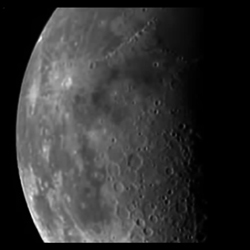EPOXI
Two intriguing investigations -- One flight-proven spacecraft
News: Deep Impact Team 'Celebrates' New Year's Eve with Earth Flyby, 2007.12.31
Press Release
Deep Impact Team 'Celebrates' New Year's Eve with Earth Flyby2007.12.31
COLLEGE PARK, Md. -- On New Year's Eve the University of Maryland-led Deep Impact team again is celebrating a holiday in a way that few can match, as their Deep Impact spacecraft "buzzes" the Earth on a flyby that marks the beginning of a more than two-and-a-half-year journey to comet Hartley 2.
In 2005, the Deep Impact team, led by University of Maryland astronomer Michael A'Hearn, celebrated July 4th by smashing a probe into comet Tempel 1 to give the world its first look inside a comet.
The trip to Hartley 2 is one part of a new two-part mission for the team and its Deep Impact spacecraft. During the first six months of the journey, the Extrasolar Planet Observations and Characterization (EPOCh) mission team will use the larger of the two telescopes on the Deep Impact spacecraft to search for Earth-sized planets around five stars selected as likely candidates for such planets. Upon arriving at the comet the Deep Impact Extended Investigation (DIXI) will conduct an extended flyby of Hartley 2 using all three of the spacecraft's instruments (two telescopes with digital color cameras and an infrared spectrometer. The name for the new combined mission, EPOXI, is a combination of the names of its component missions (EPOCh + DIXI = EPOXI).
The team is using the flyby of Earth to calibrate the spacecraft's instruments for the new mission and to help slingshot it on the way toward Hartley 2. Although the spacecraft will come closest to the Earth on New Year's Eve, the Maryland-led team has already begun its calibration work.
"On Saturday, 29 December, two days before its close flyby of Earth, the Deep Impact flyby spacecraft made observations of the moon to calibrate its instruments for its new mission, EPOXI," said A'Hearn. "Some calibrations are obtainable only on a bright, large source, like the moon when reasonably close to it. It looks as though everything operated just as the science team asked it to operate and you can't ask for anything better than that," he said.
"This Earth gravity assist provided a unique opportunity for us to calibrate our instruments using the Moon," said Jessica Sunshine, a senior research scientist at the University of Maryland. "In particular, the Moon is very useful because it fills the entire field of view of the infrared spectrometer. The results show that our spacecraft pointing and commanding was spot on. We also made measurements which will allow us to cross-calibrate our instruments with telescopic data and, in the very near future, with a wealth of lunar measurements from new orbiting spacecraft. These data will significantly improve the science from EPOCh observations of Earth and the DIXI flyby of comet Hartley 2, as well as from Deep Impact's prime mission to comet Tempel 1," said Sunshine who is deputy principal investigator on DIXI.
Past releases with more information about the EPOXI mission and the previous Deep Impact mission to Tempel 1 can be found by search for "Deep Impact" using the search box in the upper right portion of this Web page.
Images of the moon taken by the Deep Impact spacecraft and updates about the mission can be seen on the EPOXI Web site.
Journey to Hartley 2 Graphic
After its encounter with Tempel 1 (green arc), the Deep Impact spacecraft, now being used for the EPOXI mission, continued in its orbit (yellow ellipse) around the sun bring it past Earth on New Year's Eve. Along the way, there were trajectory correction maneuvers (TCMs) to adjust the spacecraft's path so that after the flyby it will be in an orbit (white circles) that will intersect with comet Hartley 2 (red arc) in 2010. During the flyby, the spacecraft experienced a gravity assist from Earth (blue circle) that stole some of the orbital energy from the spacecraft, changing its orbit from the yellow path to the white one. Additional Earth flybys in 2008 and 2009 will refine the orbit even further.
Lee Tune
University of Maryland, College Park
301-405-4679
ltune [at] umd [dot] edu
RELEASE: 07186, Source


